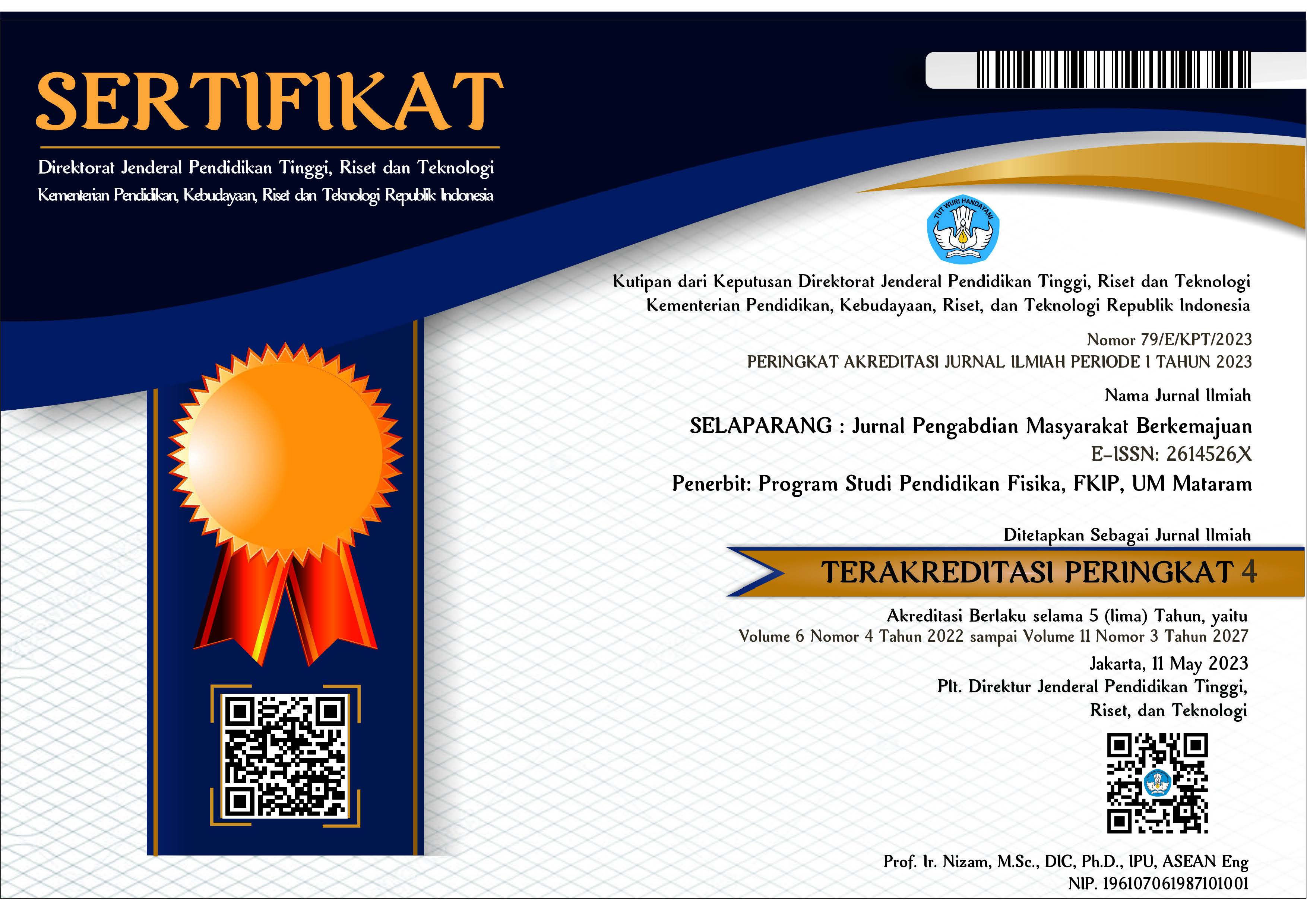Pemanfaatan skala danjon sebagai media untuk mengukur rona gerhana
Abstract
Abstrak
Proses terjadinya Gerhana Bulan Total merupakan fenomena astronomi yang terjadi ketika seluruh permukaan Bulan tertutupi oleh bayang bayang Bumi atau disebut dengan umbra. Hal ini dapat terjadi ketika konfigurasi antara Bulan, Bumi, dan Matahari berada pada satu garis lurus. Oleh karena itu, fenomena Gerhana Bulan Total akan terjadi bersamaan dengan fase Bulan Purnama. Tujuan dilakukannya pengabdian ini adalah untuk mengamati Gerhana Bulan. Metode yang digunakan adalah observasi dan pengisian angket skala Danjon. Pelaksanaan kegiatan dilakukan pada tanggal 8 November 2022 yang dimulai pada pukul 18.00 WITA dengan peserta yang berasal dari masyarakat umum dan masyarakat Universitas Muhammadiyah Maumere. Berdasarkan hasil implementasi diketahui bahwa kondisi cuaca pada saat pelaksanaan sulit dilakukan pengamatan karena kondisi mendung disertai gerimis. Namun, peserta yang mengamati dapat menilai kecerahan gerhana bulan
Kata kunci: gerhana bulan total; astronomi; skala danjon; pengamatan.
Abstract
The total lunar eclipse process is an astronomical phenomenon that occurs when the Earth's shadow, called the umbra, covers the entire moon's surface. It can happen when the configuration between the Moon, Earth, and Sun is straight. Therefore, the total lunar eclipse phenomenon will co-occur with the complete moon phase. The purpose of doing this service is to observe the Lunar Eclipse. The method used is observation and filling out the Danjon scale questionnaire. The implementation was carried out on November 8, 2022, starting at 18.00 WITA with participants from the general public and the Universitas Muhammadiyah Maumere community. Based on the implementation results, it is known that the weather conditions at the time of observation were challenging because of cloudy conditions accompanied by drizzle. However, participants can judge the brightness of the lunar eclipse.
Keywords: total lunar eclipse; astronomy; danjon scale; observation.
Keywords
Full Text:
PDFReferences
Akbar, R., & Mustaqim, R. A. (2020). Problematika Konsep Bentuk Bumi dan Upaya Mencari Titik Temunya dalam Penentuan Arah Kiblat. Shar-E : Jurnal Kajian Ekonomi Hukum Syariah, 6(1), 43–52. https://doi.org/10.37567/shar-e.v6i1.17
Aria Utama, J., Asmoro, C. P., & Achmad, A. R. (2021). Skala Danjon dan Magnitudo Visual Gerhana Bulan Total 26 Mei 2021. Prosiding Seminar Nasional Fisika, 7(0), 341–347. https://eclipse.gsfc.nasa.gov/,
Bagdoo, R. (2021). Lunar Eclipses and Allais Effect. Journal of Modern Physics, 12(13), 1783–1794. https://doi.org/10.4236/jmp.2021.1213104
Chebolu, S. K. (2020). Packing Moons Inside the Earth. Math Horizons, 27(4), 18–20. https://doi.org/10.1080/10724117.2020.1714329
Colmenero, N. P., Córdoba, J. V. A., & Fullana i Alfonso, M. J. (2021). Relativistic positioning: including the influence of the gravitational action of the Sun and the Moon and the Earth’s oblateness on Galileo satellites. Astrophysics and Space Science, 366(7), 66. https://doi.org/10.1007/s10509-021-03973-z
Fauziah, E. S., & Kurniawan, R. R. (2022). Fenomena Gerhana Dalam Hukum Islam Dan Astronomi. Jurnal Ilmu Al-Qur’an Dan Tafsir, 1(1), 1–15.
Hikmatiar, H., Jufriansah, A., Khusnani, A., & Saharul. (2023). Lux Meter pada Smartphone untuk Pengukuran Perubahan Tingkat Kecerahan Langit. Bincang Sains Dan Teknologi, 2(01), 1–10. https://doi.org/10.56741/bst.v2i01.250
Izzuddin, A., Rahman, M. H., & Riza, M. H. (2021). Teleskop Ioptron Cube II dalam Penentuan Arah Kiblat. AL - AFAQ : Jurnal Ilmu Falak Dan Astronomi, 3(1), 25–40. https://doi.org/10.20414/afaq.v3i1.2776
Khusnani, A., Jufriansah, A., Wahyuningsih, W., Fitri, M., Rahman S., N. H. Abd., Yanto, Y., Subandi, Y. K., & Sulastri, E. (2022). Pemanfaatan Aplikasi Stellarium dan Alat Peraga Astronomi NASE (Network for Astronomy School Education) sebagai Pembelajaran Etnoastronomi. Surya Abdimas, 6(4), 657–663. https://doi.org/10.37729/abdimas.v6i4.2114
Malasan, H. L., Ros, R. M., Kunjaya, C., Soegiartini, E., Aprilia, & Romadhonia, R. W. (2020). Empowering Science Teachers in Indonesia through NASE Workshops. Proceedings of the International Astronomical Union, 367, 30–33. https://doi.org/10.1017/S1743921321000582
Mukarromah, S. L. (2019). Perhitungan Gerhana Matahari dengan Algoritma NASA. Jurnal Studi Dan Penelitian Hukum Islam, 99(2), 99–113. http://jurnal.unissula.ac.id/index.php/ua
Nugroho, H. S., Nurjanah, A., Nugraha, M. G., Arya Utama, J., Susanti, H., Asmoro, C. P., & Kirana, K. H. (2018). Analisis Pengaruh Gerhana Bulan Total 31 Januari 2018 pada Percepatan Gravitasi Di Permukaan Bumi menggunakan Sensor Photogate pada Bandul Matematis Teroptimalisasi. Prosiding Seminar Nasional Fisika (SINAFI), 358.
Pastilha, R., & Hurlbert, A. (2022). Seeing and sensing temporal variations in natural daylight (pp. 275–301). https://doi.org/10.1016/bs.pbr.2022.04.013
Riza, M. H. (2020). Fenomena Supermoon dalam Perspektif Fiqh dan Astronomi. ELFALAKY, 4(1). https://doi.org/10.24252/ifk.v4i1.14163
Setiyawan, A., Budi Darsono, F., Yusuf Firdaus, D., Faksi, S., & Syamsuddin Nurul Iman, M. (2024). Sosialisai Kendaraan Listrik Berbasis Baterai (KLBB) bagi driver online. SELAPARANG: Jurnal Pengabdian Masyarakat Berkemajuan, 8(1), 31–36.
Spathopoulos, V. M. (2021). A set of student activities for the simulation of ancient and medieval astronomical observations. Physics Education, 56(2), 023010. https://doi.org/10.1088/1361-6552/abdee0
Wullenweber, N., Lange, A., Rozanov, A., & von Savigny, C. (2021). On the phenomenon of the blue sun. Climate of the Past, 17(2), 969–983. https://doi.org/10.5194/cp-17-969-2021
DOI: https://doi.org/10.31764/jpmb.v8i2.22869
Refbacks
- There are currently no refbacks.

This work is licensed under a Creative Commons Attribution-ShareAlike 4.0 International License.
______________________________________________________
Jurnal Selaparang
p-ISSN 2614-5251 || e-ISSN 2614-526X
EDITORIAL OFFICE:



















